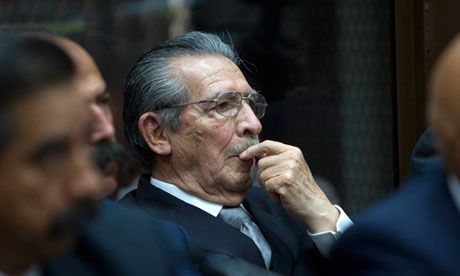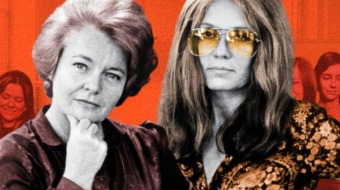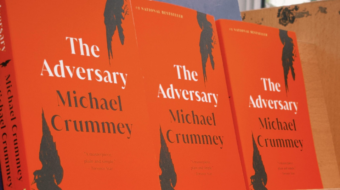
Good news from Guatemala: Former general and president Efrain Rios Montt, yet another student of the U.S. Army School of the Americas (now called Western Hemisphere Institute for Security and Cooperation) in Fort Benning, Georgia, will face charges for genocide and crimes against humanity.
The charges result from his 15-month presidency in 1982 and 1983, which consisted of a bloody genocidal rampage in which thousands of Guatemalans, most of them indigenous Mayans, were murdered.
For several years, Rios Montt was protected from prosecution because he was a member of the Guatemalan Congress, and so had immunity. Before that, his impunity was based on sheer physical fear. The immunity ended when he left Congress a year ago. Charges were filed last year, and this January 28 Judge Miguel Angel Galvez ruled that his case and that of another general, Jose Rodriguez Sanchez, should go to trial.
But in the dock next to him should be the U.S. Central Intelligence Agency and former officials of the Reagan administration and other U.S. political figures who were his friends, funders, and enablers.
The story of Guatemala’s bloody civil war starts in 1954, when the Eisenhower administration decided that liberal reforms undertaken by its center-left president, Jacobo Arbenz, could not be tolerated, not least because Guatemalan land reform threatened the properties of the United Fruit Company, in which powerful American figures (Secretary of State John Foster Dulles and his brother, CIA director Allen) had investments.
So a military force organized by the United States succeeded in driving Arbenz into exile. After this, Guatemala was ruled by the military or their civilian frontmen. Marxist guerrillas grouped into the Guerrilla Army of the Poor (EGP in Spanish) resisted. In the bloody war that ensued, up to 200,000 people were killed, the immense majority by the armed forces and paramilitary groups.
Rios Montt seized power from military dictator Fernando Romeo Lucas Garcia on March 23, 1982. As an Evangelical Christian (a lay pastor in the U.S. based Church of the Word), Rios Montt was willing to go after progressive Catholic clergy and laity. He was supported by major U.S. right-wing Evangelical leaders, such as Pat Robertson.
Rios Montt also saw the indigenous people of Guatemala, who constitute nearly half of the entire population, as a threat to be suppressed. He focused his repressive energies on the Ixil people of the El Quiché Department in Northwestern Guatemala, with a policy of “guns or beans:” People who submitted would be fed, everybody else would be killed. Hundreds of villages were destroyed and thousands of innocent civilians, including women, children and the elderly, were massacred. The indictment against him mentions a figure of 1,771 victims, but most observers think there were probably tens of thousands. Up to 600 villages were destroyed. Other massacres took place in the village of Dos Erres in the Peten region to the north and elsewhere.
A special military unit, the Kabiles, helped this ethnic cleansing. Their training was and is designed to strip them of all human fellow-feeling. Many atrocities have been attributed to this unit, which still exists and was last heard of as having been sent to Central Africa to fight the forces of Joseph Kony.
While Rios Montt’s frenzied bloodbath was under way, he was being lavished with praise and material support by the Reagan administration. In 1982 Reagan called the Guatemalan dictator “a man of great personal integrity.”
The Rios Montt government also received military help from Israel, in the form of trainers and armaments.
Another coup on August 8, 1983, removed Rios Montt from power. His successor, Oscar Humberto Mejía Victorés, kept up the murderous pace. And even when peace talks brought an end to the official war in 1996, the bloodshed continued. In 1998 this led to the murder of Bishop 1998 Juan Gerardi, who had just finished a report ordered by the Roman Catholic Church which condemned the actions of the military.
Out of power, Rios Montt continued to be a destabilizing factor in Guatemalan politics. When, in 2003, the Guatemalan Supreme Court suggested that Efrain Rios Montt could not run for president because the Constitution barred people involved in coups d’etat from doing so, Rios Montt and his daughter Zury, wife of former Republican U.S. Congressman Jerry Weller of Illinois, and their allies organized a vicious riot in Guatemala City in which buildings were burned and one person died of a heart attack.
In 2010, centrist President Alvaro Colom appointed Claudia Paz y Paz as Guatemala’s attorney general. When Colom was replaced by right wing President Oscar Perez Molina in January 2012, she was allowed to continue in this position, even though many suspect that Perez, another general, might have been involved in severe human rights violations himself. Claudia Paz has aggressively gone after not only Rios Montt and his ilk, but also drug cartels and perpetrators of Guatemala’s horrific level of crimes against women.
So finally, Rios Montt will go on trial. The main pity is that so many figures in the United States who made his mad rampage possible are not in the dock with him.
Photo: Effrain Rios Montt guim.co.uk










